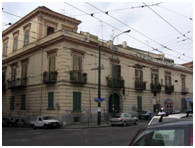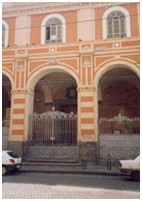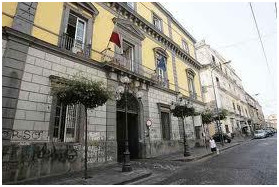
The Golden Mile
Photos of the villas at the bottom
Previously, the term Il miglio d'oro, the term Golden Mile was used to cover the distance between Herculaneum –the archeological ruins and Torre Del Greco. Today, the same term is used to indicate the area where the (formerly) opulent villas from the 18th Century are to be found. After the king of Naples had built his summer residence in the area around Ercolano, the court noblesstarted building g their “country houses" there as well.These houses belong to the so-called 122 Vesuvius villas, which extend from San Giovanni al Teduccio up to Torre del Greco. The official website can be found here: http://www.villevesuviane.net/
The tour starts at the beginning of Corso Resina, at the border toPortici, shortly after the Royal Palace, former residence of Charles III of Bourbon, who he spent his holidays there. In this palace he founded the famous Accademia Ercolanese and the museum where the archaeological remains of Herculaneum, Pompeii and other places were registered in the 18 Century.
The first country house you encounteris Villa de Liguoro, one of the oldest mansions of the 18th Century. The original plane geometry has unfortunately been modified later on.
The villa is located in Via Roma, Corso Resine, the ancient Via Cecere, where the first discoveries and excavations during the Bourbons - rule took place. Along this road one of the most beautiful villas of the 18th century - Villa Signorini- is located. The building has been attributed to Domenico Antonio Vaccaro and is considered an example of the Neapolitan Baroque.
In the garden two small pavilions and a beautiful fountain of Leda and the swan can be admired. AlongVia Roma you will reach Via Arturo Consiglio, there you should take a look at two special villas that were known in the golden era as "Casino". Not far from these mansions, there is the splendid Villa dei Papiri, which unfortunately still cannot be visited (see also our Guide "Herculaneum").
Back to Corso Resina, we can visit another villa, Villa Granito di Belmonte. Here the original staircase, which opens the view to the sea, still exists. Near this villa there is the Chiesa Santa Maria della Consolazione, which is also called St. Augustine/ Sant'Agostino Church - dating back to 1613, it houses many valuable works of art, among others pieces by Luca Giordano. Unfortunately, some of them were stolen in April 2002.
This church belongs to the grounds of the royal palace, which is located not far from there.
It is considered a good example of the Neapolitan Baroque. Along the Corso Resina on the right the Palazzo Municipale with its lovely garden can be reached, it lies opposite to the Villa of the Papyri.
From here you can have a look at the Villa of the Papyri. The technical difficulties concerning the last excavations of the villaderiving from the nature of the terrain,and can be guessed from this view. Afterwards, the tour can continue - best to the south.
On the left side you can see Palazzo Tarascone with its unusual plane geometry and on the right, Palazzo Correale, with a courtyard, which allows a partial view to the sea. Along this road to the right you will find the entrance to the Ancient Theater, where the first remains were found.
Opposite the theater is located the Church of Santa Caterina, in which a lovely altar from the 19th Century and other impressive works of art can be admired.
Behind the church there is the old Piazza Fontana. In earlier times this place was famous for anarch called "Colli Mozzi" (mutilated necks), with four Roman statues. The statues, with their heads missing at the later excavations, were removed and the arch was destroyed. It was replaced by a fountain, which depicted a "Siren/Sirene”. Also this fountain no longer exists.
Across the square a villa from the 18th Century, the Palazzo del Principe di Capracotta, is situated. Earlier this was the Palazzo Municipale (Town Hall).
From the Piazza Fontana leads the famous Via Pugliano to the Piazza Pugliana. Here the daily second-hand market takes place.
At the Piazza Pugliano the ancient Basilica of Pugliano is located. The church is of medieval origin and contains two sarcophagi from Roman times and many other ancient works of art. The church is worth seeing because it is the cultural center of the old Resina (name for Ercolano until 1969). The city was built around the church during the Middle Ages. It seemed as if the inhabitants had forgotten the ancient town of Herculaneum. Only the two sarcophagi evoke the distant Roman era.
Back to the Corso Resina. Shortly after the Roman theater the Piazza Colonna, can be reached. It is famed for its "Corricolo", a street that in the 18th Century led from Herculaneum to Naples.At this place/square,in 1861, a column was erected to commemorate the date on which Resina allied with other cities in order to finally form the southern provinces of the new, reunified Italy. After only a few meters, to the right side the entrance to the ruins of the glorious ancient city is located. The entrance to the ruins site gives a retrospective viewof the past 2000 years. The tour takes a few hours in any case –but it is worth taking the time to experience this fascinating journey into the past.On the right side of the entrance to the ruins, there is the Villa de Bisogno di Casaluce, from where underground passages lead into the old city. At this villa a stone was placed to mark the starting point of the Golden Mile.
Further south you will find on the left side one of the most beautiful villas, Villa Aprile. It was known as the "queen" of all the villas in the 18th Century. The villa was a famous hotel residence; where illustrious guests spent their holidays. The garden is still largely in its original condition. After extensive renovations, the Villa Aprile is now called "Miglio d'Oro–Park Hotel" and it houses one of the leading hotel restaurants in the region. Resina was known in the past for its friendly and warm climate - that's why it attractedguests until the beginning of the twentieth century in the villas that were remodeled to residences.
Near the Villa Aprile or the Hotel Miglio d'Oro, lies Villa Durante, which has been restored as well. Opposite the villa, there are the gardens of the Villa Durante, which are now affiliated to another Vesuvius villa, theVilla Tosti di Valminuta. Visa-a-vis is the famous Via Quattro Orologi, where once the International Archaeological Center, accommodated at the Villa Maiuri, was located. This villa, in the Neapolitan style of Liberty (?), originally called Villa Ravone, was purchased by the municipality of Ercolano, has since been restored and opened to the public. Crossing the road via Quattro Orologi, on the left side there is the Villa Arena, whose garden was famous for its beautiful pine trees in the past. The Bourbon king Ferdinand IV of Bourbon rested often under their shadows.
On the other side of the street Villa Campolieto is located, the masterpiece among the villas of the 18th Century. It was built by the architect Luigi Vanvitelli between the years 1755 and 1775. This villa was the firstto beacquired by the Foundation Ente Ville Vesuviane (http://www.villevesuviane.net). renovated anew In 1971, it offers today space for concerts, exhibitions and seminars. The garden and some of the beautifully decorated rooms are open to the public in the morning.Opening hours for the villas Campolieto, Ruggiero in Herculaneum and the Villa delle Ginestre in Torre del Greco are:
Tuesday to Sunday from 10 am to 1 pm
Closed on Mondays, on 1stof January, 15th of August, 24th, 25th and 31st of December
Further Information at (039) 081 732 21 34
A little further to the right there is the splendid Villa Favorita, built by Ferdinando Fuga - it was the favorite royal residence. In the park, which is approximately 1km long and extends almost to the sea, there are pavilions and a beautiful branch called the Villa of the Mosaics. The park ends at a Cafè house that is overlooking the sea. The Villa of the Mosaics was temporarily also the residence of the Viceroy of Egypt Ismahel Pasha and his court. Some of the rooms are in Chinese and Arabic style. The park has been renovated and is fully accessible to the public.Opposite the Villa Favorita is theVilla Battista, which is towered/topped by a magnificent tower.
In the direction of Torre Del Greco, there are other, magnificent villas and palaces including the Palazzo del Principe di Migliano, which was rebuilt during the last century. The Villa Vargas Macchucca, an interesting example of the architecture of the 18th Century is, unfortunately, run down completely. In its vicinity one of the curious mansions is located: whose exterior walls were decorated in the famous red Pompeianstyle. Next to the villa is the beautiful Church of Santa Maria del Pilar, another good example of the Neapolitan Baroque. On the other side of the stree lies the Villa Lucia, with its magnificent garden and a famous statue of San Gennaro. The garden is adjacent to the large park of the Villa Materazzo, a magnificent mansion of the 19th century, which was renovated by the municipality.
Going back towards the city center, along Via Alessandro Rossi, close to the Stadion you findVilla Ruggiero, another beautiful mansion from the 18th century, which houses a public library. From the gardenyou see Mount Vesuvius. Architecturally, the villa has a special charm.
In the vicinity of Villa Ruggiero there is another country house, the Villa Giulio De La Ville, which was unfortunately abandoned. The Golden Mile ends at this point. Should you still have interest, desire and time, it is advisable to visit even some more of a total of 112 villas.
Here further information and some tours can be viewed:
http://itinerari.seenapolisea.it/percorsivesuviani.php
Royal palace at Portici – Painting century 1800

Villa de Liguoro - http://sit.provincia.napoli.it/MDScheda.asp?key=4010

Villa Aprile - http://sit.provincia.napoli.it/MDScheda.asp?key=4010

Villa Signorini - http://www.villasignorini.it/

Villa Signorini - http://www.villasignorini.it/

Villa Signorini

Villa Granito di Belmonte, Corso Resina 11, Ercolano

Church Sant’Agostino

Palazzo Municipale

Palazzo Tarascone

Palazzo Correale

Church Santa Catarina

Palace of Prince Capracotta - http://sit.provincia.napoli.it/mdscheda.asp?key=4006

Basilica of Pugliano

Basilica of Pugliano

Villa Bisogno di Casaluce

Villa Aprile - http://www.migliodoroparkhotel.it/en/servizi

Villa Durante - http://sit.provincia.napoli.it/MDScheda.asp?key=4011

Villa Tosti di Valminuta - http://sit.provincia.napoli.it/museodiffuso/mdb2Viewurba.asp?key=4024

Villa Maiuri or Villa Ravone –

Villa Maiuri – Villa Ravone http://sit.provincia.napoli.it/museodiffuso/mdb2Viewurba.asp?key=4031&x_Denominazione=villa%20maiuri&searchval=villa%20maiuri&tipo=urba

Villa Arena - http://sit.provincia.napoli.it/

Villa Caompolieto - http://www.aiaercolano.it/ville_vesuviane.htm

Villa Campolieto

Villa Campolieto – Frescoes

Villa Favorita

Villa Favorita – Garden villa

Villa Battista

Villa Ruggiero

Villa Ruggiero

Villa Battistahttp://www.prolocohercvlanevm.it/sito/index.php?option=com_phocagallery&view=category&id=16&Itemid=167&lang=en&limitstart=20

Villa Battista

Villa of Prince of Migliano

Villa Vargas Macchucca

Church Santa Maria del Pilar

Villa Lucia - http://sit.provincia.napoli.it/MDScheda.asp?key=4014

Villa Materazzo - http://www.prolocohercvlanevm.it/sito/index.php?option=com_phocagallery&view=category&id=16&Itemid=167&lang=en&limitstart=20

Villa Petti Ruggiero

Villa Giulio della Ville - http://sit.provincia.napoli.it/museodiffuso/mdb2Viewurba.asp?key=4013






